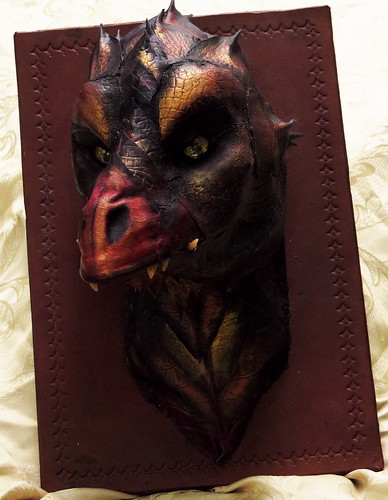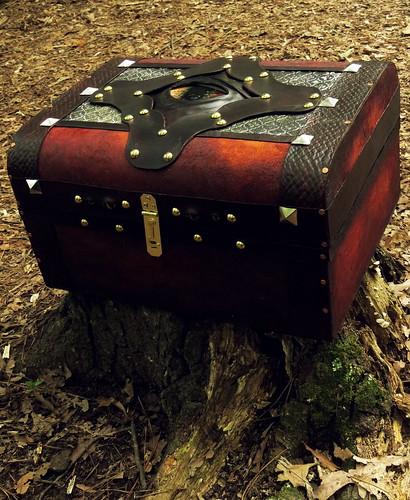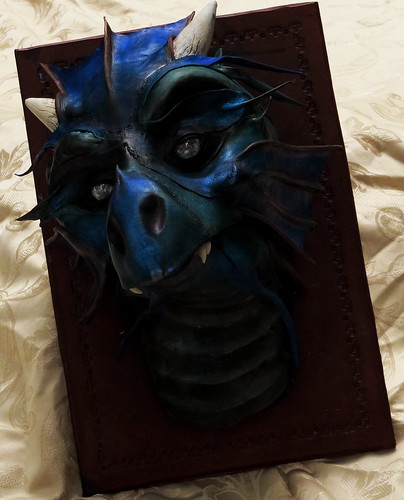|
Oh yay! A leather working thread! This is actually what I do. I also teach classes. Would it be spammy to post the schedule to see if any goons want to spend an afternoon playing with dead cow bits with me?
|
|
|
|

|
| # ¿ Apr 28, 2024 18:15 |
|
Pagan posted:Not at all, and feel free to contribute. I consider myself to be a complete newbie to all this, and I'm always trying to learn more. Nifty then. I'm the lead artist at Fine Line Leather Design. We make neat stuff. Like books  Leather sculpting  Costume armor  Masks  And other fun stuff. Like I said, I teach classes from time to time out of the Tandy store in Richmond, Virginia. If anyone has interests, I'll post it the next time there's a class schedule posted. If you live in the rest of the world, if you go to Tandy's blog, there's a list of their classes on the left. http://blog.leathercraftlibrary.com/ I will tell you that Tandy is very touch and go as far as classes. Many stores don't offer them, some are astounding workshops with master leatherworkers, and some are fumbling through a project with someone who has only done this once or twice themselves. I can't vouch for your experience. I hightly recommend checking out http://www.leatherworker.net It's a decent community online, and tends to weed out the idiots fairly quickly. Also, http://www.leatherlearn.com is a great blog for this. The major problem you run into with leatherworking is that much of it is geared towards the same style. If you're not interested in Western carving, holsters, and saddles, you can run into a brick wall for information. It makes things difficult, but not impossible. Which... offhand anyone have any ideas where I can trade awesome leathery goodness for website design? Linear Ouroboros fucked around with this message at 20:43 on Dec 31, 2012 |
|
|
|
Baron Fuzzlewhack posted:
Lol. James or Nikki? Both learned bookbinding from me, hehe. I actually have taught all four of the Richmond staff, they are great. I will tell them when I stop by tomorrow they are representing well
|
|
|
|
Pardalis posted:I think you can oil it to finish it off. You want to treat it with *something*, though. Quick answer, you'll want more than that unless you're planning on treating it frequently. Vegetable tanned leather is permeable, which is why it can be cased and stamped. SOMETHING has to seal it in when you are done--if not you'll be dealing with stains, smells, mold and mildew being able to get into your leather really really easily. Neatsfoot is technically a conditioner. Meaning it soaks into the core of your leather and helps to replenish the natural oils and keep the leather flexible and supple. As it is an oil, it will repel water--for a while. But the oil will eventually work its way out of the leather and it will take any dyes out with it. Also, it's really easy to overdo it with neatsfoot. You'll see guys who saturate their leather in neatsfoot, and walk around with an oil slick on their butts where their wallet is--like a napkin under fast food french fries. Plus, neatsfoot will darken your leather. Like, a lot. There are other conditioners, and generally speaking, the thicker the liquid, the slower it will work its way out of the leather, but generally you want to think about conditioners for preserving and maintaining your leather instead. A finish goes on top of your leather, and stays there. It's basically a protective barrier against water and the outside world. Acryllic based finishes have the best waterproofing, but also tend to make your leather less flexible and more likely to crack. I've seen situations where people have soaked leather in acryllic finishes, and then you can actually snap off pieces like it's dried wood. They also tend to have some gloss to them, and look less "natural". You'll also run into issues if you condition your leather down the road. Acryllics either will resist the oil completely, or cause it to buckle and crack. You also have to be careful to put acryllics on well dried leather, if you rush after dying it will crack. Oh, and some acryllics turn if you store them in the sun. You'll open them and smell nasty rotten eggs. Wax based finishes have a lower gloss, and tend to leave leather looking and feeling more natural. They will want to sort of rub off after time, especially on products where there's a fair amount of fabric/leather attachment. (Think wallets, belts, backs of purses) If you are maintaining with fairly regular reconditioning, it shouldn't be an issue, but it runs into issues of whether or not you trust the person with the care of their leather. (the care sheets I hand out with my leather products include "don't get wet" followed by "don't feed after midnight") So, my answer to all of this has been combos. I mix most of my own finishes. There's a few different formulas you'll find online, including ones using everything from resins to floorwaxes. My finishes vary. I have five different ones right now, but I'm always tweaking to get the right spectrum of glosses and to help prevent yellowing. If I ever perfect them, I might sell them, lol! But for yours, if you are looking for complete natural looking leather that will be protected, go with carnuba wax. Skip Tandy's brand, way too expensive. Instead get it from the dollar store in the car wash area. Just be sure to check there's no weird additives or dyes, you just want the pure stuff. It'll give you such a low gloss it barely looks like it's there, and provide you with waterproofing and keeps your leather nice and flexy. I wrote that up off the cuff and poorly, but I'm realising if anyone has any interest in an infodump, I can seriously post basically what I teach in my classes. I'll just take some time to edit it up a little. But this is what I do for a living, so I have a bit of knowledge on hand.
|
|
|
|
Yup. In addition to the no-metal hammer thing, the other thing to watch out for is your punch surface. A nonforgiving surface like metal or granite will just ruin your cutting edge as soon as it goes through. It'll pancake out. Wood is usually no good either. If you hit a knot of section of the wood where one part is firmer than the other, you can split your punch tube, or dull out one edge. With a larger punch (for strap ends) I once saw someone actually crack it so that a chip flew up. If he hadn't been wearing glasses, it would have hit his eye. Instead he just had a chip in his lens. What you want is poly (think of a kitchen cutting board) or rubber cutting board. A thick piece of leather works nice. I got ahold of an ugly but huge chunk of bullhide that's almost a half an inch thick which I use frequently. Put your cutting surface on a stable base. A wobbly table will give or bounce and take some of the strike force away, making it harder to punch through and more likely you'll move the tool accidently.. This is why you see most leatherworkers working on a slab of marble. It should only take one or two blows to go through. You're not hammering a nail, give it some oompf. If you take more blows to make the cut, you'll chew up the leather going through. Don't worry about the leather left inside, it'll pop out when it gets full on its own. Be careful of youtube videos, there's a lot of idiots out there, but there's some good guys out there. https://www.youtube.com/watch?v=HMMtChY2meY I probably will infodump a little later. Helps to keep the thoughts active to teach.
|
|
|
|
I have seen plenty of people using poly/plastic dollar store cutting boards and they work great. I am a huge proponent of cheap leather working. There's tools you should splurge on and those you can cheat.
|
|
|
|
If you know of anyone who is getting marble countertops done, ask them to keep the sink/ edges, works well too. There used to be a marble place that would be dumping scrap--I'd have my customers go over for $5 and pick through their "junk" for pieces. The other cheap way to go at just home depot is paving stones/stepping stones. Hell, I knew someone who had an extra thick piece--he had a miscut tombstone! It doesn't have to be marble or granite either. Faux stuff like corian or polish concrete works well too. You just want a smooth, hard, nonporous, heavy and dense, but not metal or wood. The only issue is thickness, you want something at least an inch thick so you can pound on it.
|
|
|
|
I make leatherwork professionally, so I spend most of my time making stock and taking commissions (which I may or may not want to do). So I rarely get a chance to make the things in my head. I'm an artist again at DragonCon, and it's really my one excuse to sort of let loose and be really creative. Enchantress by Fine Line Leather Design, on Flickr The hooded cowl is suede and embroidered. The bracers are DragonBelly style. Both of those are my normal stock. The book is what's going in the art show. It's huge, features a large taxidermy eye, sculpted leather, and the background is this fleshy, touchable sheepskin I found and distressed. Coptic bound.  Iron Dragon by Fine Line Leather Design, on Flickr Sculpted dragon head. Made from about 6 different types of leather. I made the backstory that he guarded an iron mine for years.  Necromancer's Chest by Fine Line Leather Design, on Flickr Chest. Leather, another eye (I like eyes) but this one I hand painted. There's more eyes around the opening. Lots of brass bits, lined it in black velvet.  Carribean dragon by Fine Line Leather Design, on Flickr Another sculpted dragon head, this one is blue/green/purple. Normally my friend the photographer picks up colors better, but this one was sort of washed out.
|
|
|
|
TheNothingNew posted:I don't have to tell you, but you've got some gorgeous work there, Linear Ouroboros. I do use longstitch binding on some of my pocketstitch books as well, and actually know and teach several other methods. But in all honestly, I prefer Coptic over the rest for a few reasons. It's a portable technique. Now, on that giant tome sized one, it takes up room, but on a normal sized book, I can comfortably do it on a small tabletop. There's no crazy things like looms, no messy glue, all I need is an awl, a needle thread and paper. You can also comfortably set it down mid binding and come back, tighten up your last stitches, and go. I've Coptic bound books in hospital beds with an oxygen mask on, no problem. Creatively, the covers become these self containted and flat pieces of artwork that I can work on individually without working on the layout of the final project. Aesthetically, I find that people tend to register that it's "handmade" more because it's so obviously NOT machine done. I looks gorgeous, but also labor intensive, archaic and just not "the norm". The history of the binding is a major selling point. I have a sign (which needs repair) that talks about the Nag Hammadi texts and the ancient, sacred nature of the binding. Anything I can do so that people don't compare my prices to Walmart is a great thing. Plus, I demo it and it's like magic to customers the way that the book comes together. There's people who just can't quite get the idea, I'm just weaving paper and somehow a book comes out of the end. I also find it a drat useful binding. It sits flat, so it's a great lefty book, a good sketchbook, a good book to read from (spellbooks and songbooks and whatnot). On camera, it sits open naturally so it makes a good prop. And I've found it is probably sturdier than you'd think. The only real risk is if you had stress on the spine when its wet. I've used several over the years for idea books, autograph books, and even my family cookbook without any real issue. Uhm... yeah, I like Coptic books. The dragons are actually seperated. I sculpt the top, sides and back of the head on a hat form. The nose for these actually came from a purchased mask to get the snout and nostrils even. The eye areas, ridges, fins etc are all free formed and later added to the piece. I use really thin leathers, which wouldn't be able to hold their weight hung up for long periods of time, so they are actually filled and supported with styrofoam insulation. I want to do a full tutorial on them at some point. I have already made full sculpts out of apoxy that I used to mold over. It's simultaneously perfect and hideously high in cost to do large sculpts though, so I'm looking for a new product to use. Finally, the embroidery is done in my home by my machine, yaddah yaddah, but what you see there are purchased patterns. I'm still learning to digitize my own patterns and most of them are simple one color deals because I'm not very good at it. Those patterns came from Urban Threads, credit where credit is due. My machine is a 10 pin BabyLock I had remanufactured to be able to stand punching through leather. The backs of the leather is treated with a flexible polymer to reinforce it being punched through so many times.
|
|
|
|

|
| # ¿ Apr 28, 2024 18:15 |
|
Baron Fuzzlewhack posted:
Be cautious. Oils like neatsfoot tend to bleed out of the leather over time. On notebooks that means your paper will quickly look like a wrapper on a greasy burger.
|
|
|



